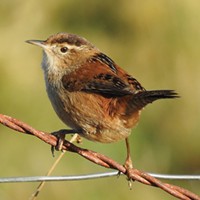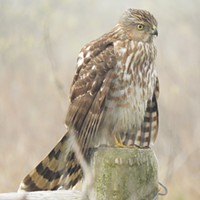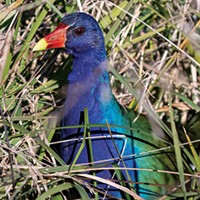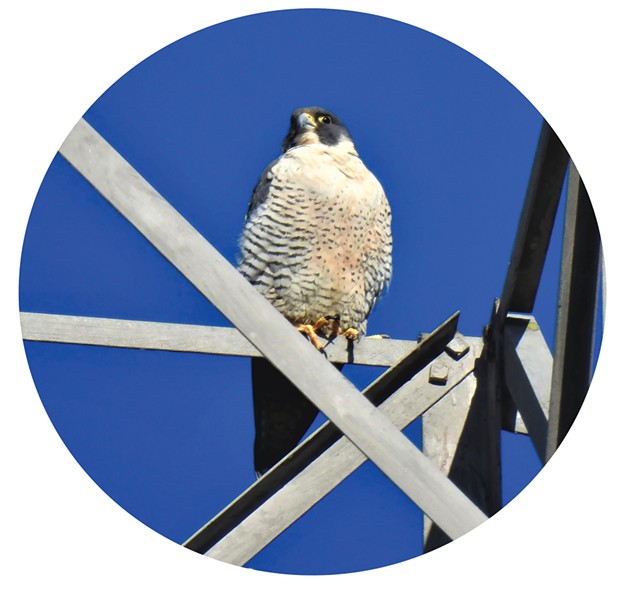[
{
"name": "Top Stories Video Pair",
"insertPoint": "7",
"component": "17087298",
"parentWrapperClass": "fdn-ads-inline-content-block",
"requiredCountToDisplay": "1"
}
]
For my 11th birthday, my parents surprised me with a pair of Jason Statesman zoom binoculars from a discount catalog. I was crazy about birds and while by today's standards the Statesmans weren't exactly cutting-edge, to me, they were perfect.
It's a common misconception that birding is an expensive hobby. It certainly can be. By the time you outfit yourself with some nice "bins," plus a camera with a ginormous lens, perhaps a spotting scope and tripod combo, and a harness with which to lug it all around ... well, you might also find yourself shopping for a second mortgage (third, in my case).
But the essence of birding is its simplicity: You just have to get out there and look. Or listen, as many sight-impaired birders do. If you're a minimalist, you could get by with a cell phone and a bird ID app like Merlin. But for the rest of us, the quintessential piece of birding gear is a good pair of binoculars.
How good? That depends on your budget, your birding habits and your personal preferences, like the amount of weight you're comfortable hoisting for sometimes hours at a time. If you wear glasses, that should factor into your search, as should birding in Humboldt, which has its own unique challenges. There's a lot of technology that goes into making great bins but choosing the right pair boils down to a few simple things.
1. Size. And what the heck do all those numbers mean? Binoculars come every configuration imaginable. For birding, 8x42 or 10x42 are popular and practical sizes. The first number is magnification: The bird in view will appear 8 or 10 times closer to you. Bigger — say, 12x — isn't usually better, since the trade-off is less brightness, increased weight and more difficulty locking onto your subject, especially if it's something fast-moving like a warbler. If you're new to birding, 8x is a solid choice.
The second number is the diameter in millimeters of the objective lens, the lens closest to the object you're viewing. This number determines how much light is let in. For birding, 42 millimeters strikes a good balance between bright, crisp images and a comfortable weight in the hand.
2. Style. Not how pretty they look dangling from your neck — how are they built? Traditional binoculars like my Statesmans use porro prisms, two chunks of fancy glass that are offset to give the bins that familiar wide-hipped shape. Most birders, though, prefer roof prism binoculars. Shaped like the letter "H," these bins have a straight line between the eyepiece and objective lens, and the diameter of the barrel is relatively consistent front to back. They're lighter and less bulky than their porro-prism counterparts and tend to hold up better to bumps and drops.
3. Special considerations for Humboldters. Let's face it: If you bird in Humboldt, you're gonna get wet. Look for models that are fully waterproof — not just water-resistant — and the words "o-ring sealed." If you plan to take them out in your kayak to chase ancient murrelets, go for "submersible." And keep in mind most binoculars don't float.
Fog is another concern but not just the Humboldt kind. Like eyeglasses, binoculars tend to fog up going from chilly to warm environments, and the moisture can get trapped inside and damage the optics. But technology has a fix. Fog-proof binoculars have had the air inside them sucked out and replaced with non-condensing nitrogen. How cool is that?
4. The key spec if you wear specs: eye relief. That's the distance in millimeters between the surface of your eye and the eyepiece lens. Look for the words "long eye relief," ideally 17 millimeters or greater, allowing you to see the full field of view while wearing your glasses. Adjustable eyecups that shorten or lengthen the eye relief are a nifty feature, too.
5. Care and feeding. With my first pair of roof-prism binoculars, I was always in a hurry. After the first few weeks I didn't bother with the case, had misplaced the protective eye caps and would occasionally give the lenses a quick polish with my shirtsleeve out in the field. Not surprisingly, the result was a big ol' scratch right across the glass.
Nowadays my bins don't go anywhere without case and caps and I keep a lot of microfiber clothes handy, sealed in ziploc baggies so they don't pick up any grit.
By the way: you'll get the most out of your nice binoculars if you treat your eyeglasses with the same care as your birding gear. Clean them with a soft, clean cloth and not the crumpled fast-food napkins kicking around the floor of your car. You know who you are.
6. How much should you spend? For all the features mentioned above, you could spend more than $2,000 — or less than $200. The difference? Frankly, part of it's in the name. The rest lies in the details: the glass, the coatings, all the little techie tricks that add extra brightness or a wider field a view. Take heart if you don't have a big budget. Shop around. Try the more affordable but also highly rated binoculars. Consider buying used from a reputable source.
Or maybe the top-end bins are the stuff of your birding dreams. That's OK, too. You've been good this long, tough year. We all have.
The right birding binoculars feel great in your hands, and the images are crisp and bright. They can stand up to Humboldt weather from rain to hail and back to rain. They're the ones that get you out the door.
I'm pretty happy with my current pair, which are roof-prism 10x42s. The 10x magnification gives me a slightly smaller field of view, but I like the bigger reach, especially for distant subjects like hawks and shorebirds (where I need all the help I can get). Waterproof and fog-proof, they handle Humboldt weather like a champ. And while they're the most expensive pair I've owned — though still in the medium range — I saved a lot by buying them factory-refurbished. They're great binoculars.
But there'll always be a special place in my heart for those Jason Statemans. They remain, to this day, the best gift I've ever received. I used them every chance I got and my interest in birds soared. I even brought them to college with me, though by that time they were showing their age — their lenses gone cloudy like the eyes of an old, faithful dog. Through those lenses I saw my first stunning snowy owl on an ornithology class field trip. That's not something I'll ever forget.
Come to think of it, one thing I did forget was to thank my folks on my birthday — there was cake waiting in the wings, after all.
But I'm thanking them now.
Sarah Hobart (she/her) is a freelance writer based in Humboldt County.
Speaking of Birding, Binoculars
-

A Chime of Wrens
Apr 11, 2024 -

Bird Names for Everyone
Feb 29, 2024 -

Spark Birds
Jan 11, 2024 - More »
more from the author
-
Condors Over Arcata
- Jun 6, 2024
-
A Chime of Wrens
- Apr 11, 2024
-
Bird Names for Everyone
- Feb 29, 2024
- More »
Latest in Get Out
Readers also liked…
-
A Walk Among the Spotted Owls
- Apr 27, 2023
































